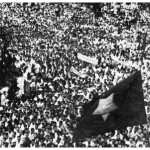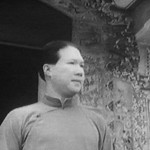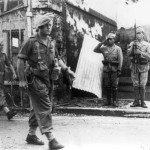
In March 1945 Japanese forces in Vietnam arrested the French governor and invited emperor Bao Dai to form a government. Bao Dai had been an impotent political figurehead under the French and was no better under the Japanese, acting as their puppet. There was certainly no faith in his ability to lead Vietnam after World War II. The Japanese were defeated after the atomic bombing of Hiroshima and Nagasaki in August 1945, which led to their surrender several days later. According to terms specified by the Allies, Japanese forces in northern Vietnam were to surrender to the Chinese, while in southern Vietnam they were to surrender to British Commonwealth forces. On August 14th Ho Chi Minh and the Viet Minh moved to take control of Vietnam, issuing a declaration of independence and forming a national government. The August Revolution, as it is sometimes known, was popular and briefly successful – however, the occupation of Vietnam by Allied forces prevented the Viet Minh from extending their authority over the entire nation.
The Japanese surrender presented the Viet Minh, the nationalist group led by Ho Chi Minh, to seize control of Vietnam. Through 1945 the Viet Minh had expanded their numbers and support in the north, the weakened French and distracted Japanese unable to stop them. In June 1945 Ho Chi Minh’s forces were strong enough for him to claim control of a ‘free zone’ in the north of the country. The departure of the Japanese in August 1945 created a power vacuum in Vietnam. This prompted Ho to call for a “national uprising”. “Many oppressed peoples the world over are vying with each other in wrestling back independence”, Ho told his followers on August 10th. “We should not lag behind! Forward! Forward!” Responding to his call, Viet Minh forces emerged from their secret bases and hidden positions in the jungles and the mountains. They mobilised and advanced on major towns and cities. The Viet Minh’s push for independence was aided by the retreating Japanese, who defied the Allied terms of surrender by handing political authority to locals rather than Westerners. Viet Minh officials were given access to government buildings and control of infrastructure and facilities. They also seized weaponry and munitions surrendered by the Japanese.

The August Revolution, as it was later called, proceeded swiftly. On August 19th Viet Minh forces marched into the northern city of Hanoi. Within another week they occupied other major cities, including Saigon in the south and Hue, the seat of the emperor, in central Vietnam. Bao Dai was forced to abdicate on August 25th, marking the end of the Nguyen dynasty. One day later, the Communist Party of Vietnam – the political core of the Viet Minh – began preparations for a Vietnamese declaration of independence. On September 2nd 1945 more than 400,000 Vietnamese – double the usual population of Hanoi – gathered in Ba Dinh Square in the capital to hear the proclamation, drafted by Ho Chi Minh. Ho’s proclamation quoted extensively from the 1776 United States Declaration of Independence, citing the values of freedom and self determination – but correctly predicting that the struggle for Vietnam was not over:
“All men are created equal; they are endowed by their Creator with certain inalienable Rights; among these are Life, Liberty, and the pursuit of Happiness. This immortal statement was made in the Declaration of Independence of the United States of America in 1776. In a broader sense, this means: All the peoples on the earth are equal from birth, all the peoples have a right to live, to be happy and free. The Declaration of the Rights of Man and Citizen of the French Revolution made in 1791 also states: All men are born free and with equal rights, and must always remain free and have equal rights. Those are undeniable truths … Viet-Nam has the right to be a free and independent country, and in fact it is so already. The entire Vietnamese people are determined to mobilize all their physical and mental strength, to sacrifice their lives and property in order to safeguard their independence and liberty.”
“The success of the Viet Minh in the August Revolution of 1945 was in many ways remarkable. Just five years before, neither the communists nor any other anti-colonial political group appeared to have a chance of overthrowing French rule. The efforts of the Indochina Communist Party to capitalise on the changed circumstances of Japanese occupation in order to build the Viet Minh movement, an independent military force and the support of so many Vietnamese, north centre and south, were extraordinary.”
Mark Bradley, historian
The Viet Minh’s declaration of independence was immediately challenged. The first challenge came with the arrival of Chinese troops in northern Vietnam, under orders to occupy the region and oversee the Japanese surrender. Around 180,000 Chinese troops arrived in Hanoi on September 9th. They found the Viet Minh in charge and stripping the capital of French businesses and street names. Confronted with overwhelming numbers of anti-communist Chinese soldiers, Viet Minh leaders were forced to agree to their terms. Left wing policies and values were suppressed. In October 1945 the Indochinese Communist Party was dissolved, an attempt to placate Chinese occupiers. Viet Minh authority was even weaker in southern Vietnam, where British officials and troops had landed. They refused to negotiate with the Viet Minh at all, making arrangements for the return of French colonial government. On September 22nd 1945 French troops attacked Saigon and raided Viet Minh strongholds, arresting or killing scores of its members. Days later the Viet Minh retaliated by murdering 200 Europeans in and around the city. This prompted the British to ship in their own troops from India. By October 1945 the Viet Minh in southern Vietnam had been decimated.

Back in the north, Ho Chi Minh was confronted with a dilemma. The Chinese occupying force in Hanoi was negotiating with French officials for the return of colonial government there. They signed an agreement on February 28th 1946, allowing the return of French troops to northern Vietnam. Ho, who feared Chinese domination more than he did the French, prepared to negotiate with the latter. “Better to sniff France’s shit for a while,” Ho allegedly remarked, “than to eat China’s all our lives”. In early March the French, under pressure from China, offered Ho a compromise: northern Vietnam could remain an autonomous (self-governing) state, provided the Viet Minh permit French troops to be stationed there for a period of five years. The south, however, would remain under French control. Ho reluctantly signed the agreement, which surrendered southern Vietnam to French imperialists.
Ho Chi Minh had no long-term intentions of recognising French authority in the south. And he believed – correctly as it turned out – that the French had no intentions of respecting Viet Minh rule in the north. Ho continued negotiations with the French through 1946, though this was largely a stalling tactic. During this time the Viet Minh and French colonial forces built up their numbers and supplies. By late 1946 there were around 50,000 French soldiers in Indochina. In comparison, the Viet Minh boasted more than 100,000 men, though it could not match the French in aircraft, artillery or military vehicles. Tensions continued to increase and civil war looked inevitable after skirmishes between French and Viet Minh forces broke out across the country. In late November French commanders attacked the Viet Minh’s supply lines by bombarding the port city of Haiphong with heavy artillery. Shells landed on local residences, killing many civilians; death toll reports vary from 800 to 6,000. The Viet Minh retaliated to this atrocity by launching an attack on Hanoi, an event that triggered the First Indochina War.

1. The surrender of Japanese troops in August 1945 led to a power vacuum in Vietnam and the launching of the Viet Minh’s August Revolution.
2. Under the surrender terms, the Japanese in northern Vietnam were required to hand power to the Chinese. Instead, it was assumed by the Viet Minh.
3. After taking control of areas in the north, Ho Chi Minh and the Viet Minh issued a declaration of Vietnamese independence in September 1945.
4. Chinese troops then arrived in northern Vietnam, allowing the Viet Minh to remain in power but forcing the expulsion of communists.
5. Southern Vietnam was occupied by the British, who facilitated the First Indochina War by allowing the return of French troops and administrators.
© Alpha History 2018. Content on this page may not be republished or distributed without permission. For more information please refer to our Terms of Use.
This page was written by Jennifer Llewellyn, Jim Southey and Steve Thompson. To reference this page, use the following citation:
J. Llewellyn et al, “The August Revolution”, Alpha History, accessed [today’s date], https://alphahistory.com/vietnamwar/the-august-revolution/.
